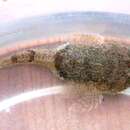Diagnostic Description
provided by Fishbase
This species is distinguished from its congeners by the following characters: a tubercle between eyes; numerous, densely-set granules on head and flanks, also between dorsal and upper lateral rows of tubercles on caudal fin; head width 77-92% HL; tubercles in dorsal row 26-29, ventral row 22-25, upper lateral row over 20 (not markedly smaller on caudal peduncle), lower lateral row up to 10; chin barbel slightly compressed, thick, about half in eye diameter in length; origin of D2 in front of anal origin; transverse rows of neuromasts on flank 19-23; a dark spot often in front of D2; sides with dark blotches and irregular dots; a blotch around base of first dorsal not reaching origin of D2 (Ref. 59043).
- Recorder
- Estelita Emily Capuli
Life Cycle
provided by Fishbase
Females probably lay eggs in 2-3 portions inside or under a molluscs shell (Ref. 59043).
Biology
provided by Fishbase
Inhabits fresh and slightly brackish waters, preferring lower reaches of rivers, deltas, lakes and freshwater limans. In rivers, this is commonly abundant in main river bed. Occurs usually on silty sand with mollusk shells (Ref. 58669). Longevity is about a year. Spawns in May-August with females probably laying eggs in 2-3 portions inside or under mollusc shell and adults die soon after spawning. Feeds mainly on chironomid larvae, amphipods and molluscs (Ref.59043). Invasive in the large tributaries of the Caspian and Black Sea (Ref. 92840).

